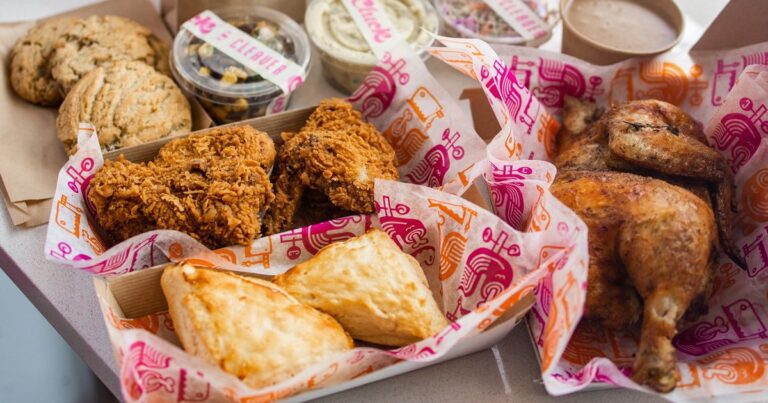Restaurants Are Possibly Starting to Pay Workers Fair Wages
Since the pandemic, the demands of restaurant and food service workers have basically come down to one key thing: the need for higher wages. Grueling, “essential” service work was deadly for many, remains dangerous, and has been done for too long on subminimum wage, or a minimum wage that isn’t actually a livable one.. However, a new study from One Fair Wage shows that things might be trending positively. The organization has documented 1,621 restaurants “that have raised wages to pay the full minimum wage with tips on top, with an average wage of about $13.50 — across 41 states in which the vast majority of restaurants were paying a subminimum wage of $5 or less earlier this year.”
The study is based on interviews with restaurant owners and a scan of job postings taken from August 24 to September 16, 2021. As economists have pointed out, low wages have become a hard line for workers. “By May of 2021, we found that over half (53%) of service workers report that they are considering leaving their jobs and the majority are leaving because their wages and tips are too low,” wrote OFW. “Nearly 8 in 10 of these workers (78%) report that they would only stay in restaurants or return to work in restaurants if they received a full, livable wage with tips on top.” For many restaurants, raising wages has become a necessity if they want to remain staffed.
Of the restaurants surveyed, those in Mississippi had the lowest average wage of $8.86 an hour before tips (the state’s tipped minimum wage is $2.13 an hour), while those in Massachusetts had the highest with $18.37 an hour (the state’s tipped minimum wage is $5.55 an hour). OFW also interviewed restaurant owners about why their willingness to raise wages, especially at a time when owners have been struggling to keep their businesses afloat. “We decided to eliminate sub minimum wage pay in our restaurants and adopted a model of all employees making above minimum wage with tips shared across all hourly non management workers,” said Katie Button, owner of Curate in Raleigh, NC. “We instantly saw better and more equitable pay across all of our workers. It has literally changed lives.”
Obviously, a casual survey of a small percentage of restaurants and their jobs postings is far from comprehensive or conclusive. As Family Meal points out, a hotel OFW lists as offering jobs for $40 an hour currently has a listing for a server position that only pays $8 an hour. But according to other sources, things are indeed looking up. The latest release from the Bureau of Labor Statistics says the average hourly earnings in Leisure and Hospitality was $16.60 in August 2021, up from $14.72 in August 2020, and that worker hours have stayed about the same.
The push for higher pay in the restaurant industry is to counter the narrative espoused by the National Restaurant Association, which argues that raising the minimum wage and eliminating the tipped minimum would be disastrous for the restaurant industry. In February, the NRA’s Executive Vice President of Public Affairs Sean Kennedy opposed the inclusion of the Raise the Wage act in the Biden-Harris Covid relief bill, saying, “The restaurant industry and our workforce will suffer from a fast-tracked wage increase and elimination of the tip credit.” The argument tends to go that raising wages will increase menu prices, which will turn off diners, causing a death spiral for the whole industry.
OFW notes minor menu increases may happen with higher wages, and that more needs to be done to support the industry so that everyone can make a living wage. But the legacy of tipped wages means you’vee already been underpaying for your meals out, as the lower prices can only exist by paying workers poverty wages. “We rarely get to see that often [restaurant owners’] dreams are dependent on the poverty of workers,” Mireya Loza, a visiting assistant professor at Georgetown University who specializes in food studies and labor, told Eater. “And if you ask me, if my ultimate dream really relies on the subjugation or poverty of employees, then it’s not a dream worth having.”
One Fair Wage hopes this leads to more legislative action around wages. “Given this shift in the restaurant industry toward full, livable wages with tips on top, it is imperative that policy makers support both workers and employers in the restaurant industry by passing federal and state policy to raise the minimum wage to $15 an hour and end the subminimum wage for tipped workers,” said Saru Jayaraman, executive director of One Fair Wage, in a statement. “After 150 years of tolerating poverty wages since Emancipation, workers are refusing to work for anything less than a full, livable wage with tips on top, and responsive employers need policymakers to support their responsiveness by creating a level playing field and signaling to millions of workers that it is worth returning to work in restaurants.”
Restaurants are still struggling, and those that made it through the pandemic are operating on even thinner margins as they deal with food shortages and making up for over a year of intermittent sales, if there were sales at all. This survey is far from comprehensive, but rather than tanking their businesses, OFW says the restaurants they surveyed “are finding that they must transition to one fair wage in order to recruit talent, fully reopen, and survive.” Hopefully more restaurants can successfully follow.






